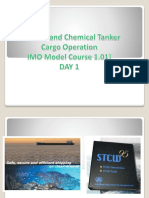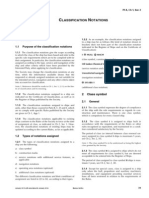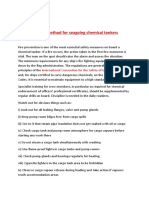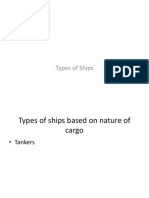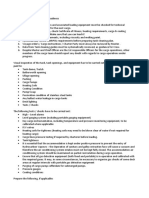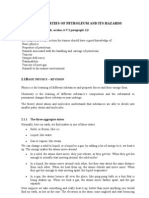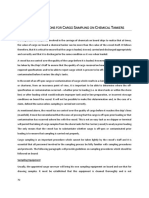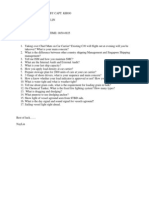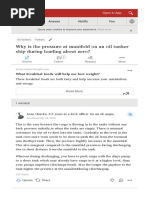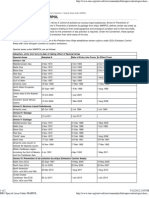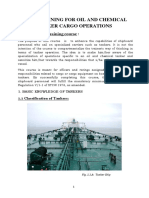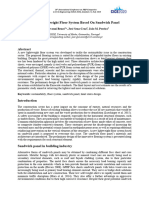United Btoct Handouts 2016 - Ok
United Btoct Handouts 2016 - Ok
Uploaded by
TarakiCopyright:
Available Formats
United Btoct Handouts 2016 - Ok
United Btoct Handouts 2016 - Ok
Uploaded by
TarakiOriginal Description:
Original Title
Copyright
Available Formats
Share this document
Did you find this document useful?
Is this content inappropriate?
Copyright:
Available Formats
United Btoct Handouts 2016 - Ok
United Btoct Handouts 2016 - Ok
Uploaded by
TarakiCopyright:
Available Formats
BASIC TRAINING FOR OIL AND CHEMICAL TANKER CARGO OPERATIONS TRAINEES MANUAL
INTRODUCTION
This course provides specific training to be duly qualified under Section A-V/1-1 of the STCW code. It is meant for
officers and ratings assigned with basic duties and responsibilities related to cargo or cargo equipment on board oil and
chemical tanker for the safety at sea and protection of the marine environment.
This course covers the competence requirements given in Section A-V/1-1-1 of the STCW code adopted by the
International Convention on Standards of Training, Certification and Watchkeeping for Seafarers, 1978 as amended in
2010.
Course Intended Learning Outcomes (Objectives):
Upon completion of the course, the trainees will be able to:
Familiarize with the equipment, instrumentations and controls used for cargo handling on oil and chemical tankers;
Demonstrate knowledge and understanding of safety awareness to apply proper and safe procedures at all times
when carrying out various operations onboard oil and chemical tankers;
Familiarize with proper planning, the use of checklist and the time scales involved in various cargo handling;
Describe and enumerate emergency procedures and co-ordinate actions during emergencies;
Improvement ability to promote safety and protect the marine environment;
Identify the steps to be taken during the event of spillage.
MODULE I: SAFE CARGO OPERATION OF OIL & CHEMICAL TANKERS
Basic Knowledge of Tankers
Definitions and Evolution of Oil and Chemical Tanker Construction
Tanker – A ship designed to carry liquid petroleum cargo in bulk, including a combination carrier when being used
for this purpose.
Oil tanker – A ship constructed primarily to carry oil in bulk.
Chemical tanker – A ship designed for the carriage of chemical product in bulk.
Evolution of Oil and Chemical Tanker Construction
Carriage of oil in conventional ships
Construction of vessels to carry oil in bulk
Use of longitudinal divisions and transverse bulkheads to form tanks
1960 North America and West European countries increased demand for crude oil
Increase in sizes to VLCC and ULCC (dramatic changes in sizes of oil tankers)
Transportation of oil, chemicals and liquefied gas in bulk
Pollution problems and fire/explosion hazards leading to International control and regulations
Development of SOLAS and MARPOL Convention
Increasing use of training to improve safety and reduce pollution
The STCW Convention and Chapter V of that convention
The development of double hulled tankers
Implementation of ISM Code, BCH/IBC Code
Elizabeth Watts – 1st tanker transported the full cargo of crude oil across the Atlantic in 1861.
Zoroaster – all purpose built tanker vessel utilized the hull for containment of oil in 1878.
Gluckauf – 1st oil tanker powered by dedicated steam-driven ocean going tanker built in Great Britain in 1886.
Exxon valdez (1996) – The United States passed the Oil Pollution Act (OPA-90) which excluded single-hull tank
vessels over 5,000 gross tonnage or more from U.S waters from 2010 onward.
Erika (1999) and Prestige (2002) – The European Union passed its own stringent anti-pollution packages which
also require all tankers entering its waters to be double-hulled by 2010.
After WW II – 1st chemicals were transported in bottles or drums on dry cargo ship, larger quantities were shipped
in bulk in the deep tanks
T2 tanker – 1st chemical tanker were converted war-built American oil tankers
1948 - 1st conversion was done of R.E Wilson.
1950 – Designed and constructed for the carriage of “acids’’, the cargo tanks were made of special alloy steel in
order to avoid contamination.
1960 – 1st real chemical tanker designed for the carriage of chemical in bulk was Norwegian MT Lind; cargo tanks
equipped with stainless steel.
Types of Oil Tankers
Crude Oil Tanker
Move large quantities of unrefined crude oil from its point of extraction to refineries.
USMCI - Issue 01 - Dec. 08, 2015 Page 1 of 18
BASIC TRAINING FOR OIL AND CHEMICAL TANKER CARGO OPERATIONS TRAINEES MANUAL
Product Oil Tanker
Generally smaller, are designed to move petrochemicals from refineries to consuming market.
Combination Carrier (Oil/Ore)
Designed to carry heavy ore concentrates in the center holds, while oil is carried in
both center holds and wing tank. Cargo pipelines installed in the wing tanks.
Combination Carrier (Oil/Bulk/Ore)
Designed to carry other types of dry bulk cargo, such as grain or coal. Oil may be
carried in one or more sets of upper hopper tanks, where there are wing tanks.
Ship Arrangement and Construction of an Oil Tanker
General Tank Arrangement
Cargo tanks
Pump-rooms
Slop tanks
Cofferdams
Peak tanks
Segregated ballast tanks
Deep tanks
Ship Arrangement and Construction of an Oil Tanker
Piping Arrangement
Internal piping in tanks and pump room
External piping (deck lines)
Crossovers
By-passes
Ring-main systems
Direct piping systems
Valves
BCH Code (Code for the Construction and Equipment of Ships Carrying Dangerous Chemicals in Bulk) – divide chemical
tankers into three ship types: Type 1, Type 2, and Type 3, which reflect the hazard rating of cargoes to be carried.
Ship Type I
Designed to transport products which require maximum preventive measure to preclude the escape of such cargo.
Intended for the transportation of products considered to present greatest overall hazard both for safety and
pollution.
Ship Type II
Designed to transport products which require significant preventive measures to preclude the escape of such
cargo
Intended to carry products of progressively lesser hazard
Ship Type III
Designed to transport products which require a moderate degree of containment to increase survival capability in a
damage condition
Intended to carry products of progressively lesser hazard
Types of Chemical Tankers
Chemical Tankers Categorized by Trade
Dedicated Chemical Tanker – dedicated for a certain type of
chemicals, transporting the same type of cargo on each
voyage.
Parcel Chemical Tanker – chemical tanker with a great
number of individual cargo tanks, which enables the vessel
to carry a great variety of small cargo ‘parcels’ on each
voyage.
Parcel tanker arrangement is designed to segregate incompatible cargoes from each other.
USMCI - Issue 01 - Dec. 08, 2015 Page 2 of 18
BASIC TRAINING FOR OIL AND CHEMICAL TANKER CARGO OPERATIONS TRAINEES MANUAL
Ship Arrangement and Construction of a Chemical Tanker
Tanks in the Cargo Area
Cargo tanks
Slop tanks
Segregated ballast tank
Tanks in the Cargo Area
Slop tanks designated or used for tank
washings and cargo residues
Cargo tanks may also be used as slop
tanks and vice versa; may also be used for
ballast
Segregated ballast tanks designed for
ballast only; equipped with a pumping
system independent of the cargo system in
order to avoid contamination by cargoes
Piping Arrangement in Cargo Tanks
Discharge line
Cargo ventilation line
Drop line
Discharge Line
Leads the cargo from the cargo tanks to the manifold by means of a cargo pump
Cargo Ventilation Line
Leads vapour from the cargo tank to the cargo ventilation riser
Vent outlets arranged to prevent the entry of water into the cargo tanks and, at the same time, to prevent the
vapour discharge upwards
Vent outlets are provided with flame screens and high-velocity devices
Drop Line
Mainly used to fill the cargo tank
Cargo Hoses
Chemical tankers are provided with chemical cargo hoses
Cargo hose constitute a weak part of the cargo handling system and that incorrect handling of the hose will
increase the danger of fire, health hazard and pollution
Material used for the Construction of Chemical Tankers
Mild steel is the normal material for the construction of chemical tanker
Mild steel is resistant to most chemicals but that its propensity to rust makes it unsuitable for chemical cargoes
Stainless steel may be “clad” or solid
Clad steel consists of a mild steel plate with a veneer of stainless steel of about 2mm thickness
Stainless steel is resistant to almost all chemicals
Stainless steel is not “stainless” or corrosion-resistant unless it is handled properly
Tank Coating Materials
Rust makes tank cleaning more difficult and may also contaminate the cargo
In order to avoid cargo contamination and to obtain a smooth surface on tank structures, mild-steel cargo tanks on
chemical tankers are always coated internally with paint that is resistant to groups of chemicals
No coating today is suitable for all cargoes shipped in chemical tankers, and that a “coating resistance list” must be
strictly followed when cargo is to be loaded in a coated tank
Most chemical tankers have their cargo-tank section divided into some coated tanks and some stainless-steel
tanks
Basic Physics
Characteristics of Cargoes
State of aggregation Vapour pressure
Liquid density Viscosity
Vapour density Pour-point
USMCI - Issue 01 - Dec. 08, 2015 Page 3 of 18
BASIC TRAINING FOR OIL AND CHEMICAL TANKER CARGO OPERATIONS TRAINEES MANUAL
State of Aggregation
A substance (matter) can present itself into three different forms or phenomena.
Solid or Crystalline State
Liquid State
Gaseous State
Solid or Crystalline State – strong attraction between the molecules of the substance; therefore, these
molecules are closely together in more or less fixed positions, e.g. in a crystal. A solid substance has its own
form and volume.
Liquid State – attraction between the molecules are much smaller, so the mutual distances are bigger;
molecules can move with respect to one another. Although there is still a connection, the liquids do not have a
form of their own and they are movable; they do have their own volume.
Gaseous State – hardly any powers of attraction between molecules, which are more completely free in
respect of one another; have no form or volume of their own; gas completely fills the container in which it is
present.
Liquid Density
Mass per unit of volume and is commonly measured in kilograms per cubic decimeter(kg/dm3) alternatively,
liquid may be quoted in kg/litre or kg/m3.
Vapour Density
The relative weight of the vapour compared with the weight of an equal volume of air at standard conditions of
temperature and pressure.
Vapour Pressure
The pressure exerted by the vapour above the liquid, at a given temperature. It is expressed as absolute
pressure.
Viscosity
The property of a fluid which restricts one layer of the fluid moving over an adjacent layer is called viscosity.
Pour-point
The lowest temperature at which a liquid will remain fluid.
Atoms and Molecules
Atoms - The smallest part of an element capable of existing alone or in combination and which cannot be
changed or destroyed in any chemical reaction.
Molecules - The smallest unit of an element, substance, or compound that can exist freely in the solid, liquid,
or gaseous state and still retain its composition and properties
Chemical Reaction
Is the change of a substance into a new one that has a different chemical
identity
Usually accompanied by easily observed physical effects, such as the
emission of heat and light, the formation of a precipitate, the evolution of
gas, or a color change
Hydrocarbon Structure
Crude petroleum, as discharged at the well head is a mixture of a large
number of different hydrocarbon molecules
Molecules are termed “light” or “heavy” according to the number of carbon atoms forming the molecule
Very heavy molecules such as asphalt and bitumen tend to be solid under normal atmospheric conditions
Intermediate molecules such as petrol (motor spirit) and diesel tend to be liquid under normal atmospheric
conditions
Very light gaseous molecules such as methane are extracted at the well head
Petroleum remaining after the removal of products such as methane is termed “crude oil”
Crude oil is a mixture of hydrocarbons which, under normal atmospheric conditions are gaseous, liquid and
solid
In an oil refining process, “distillation” refers to splitting of crude oil into a number of fractions
Each petroleum fraction has a range of physical properties specific to itself
USMCI - Issue 01 - Dec. 08, 2015 Page 4 of 18
BASIC TRAINING FOR OIL AND CHEMICAL TANKER CARGO OPERATIONS TRAINEES MANUAL
Physical Properties of Oil and Chemicals carried in Bulk
Physical Properties of Oil and Chemicals
Flashpoint Spontaneous combustion
Volatility Reactivity
Upper flammable/explosive limit Toxicity
Lower flammable/explosive limit Corrosivity
Auto-ignition temperature
Flashpoint
Lowest temperature at which a liquid gives off sufficient gas to form a flammable gas mixture near the surface
of the liquid.
Volatility
The tendency for a liquid to vaporize.
Upper flammable/explosive limit
The concentration of a hydrocarbon gas in air above which there
is insufficient oxygen to support and propagate combustion
Auto-ignition temperature
The ignition of a combustible material without initiation by a spark
or flame, when the materials has been raised to a temperature at which self-sustaining combustion occurs.
Spontaneous combustion
The ignition of material brought about by a heat producing (exothermic) chemical reaction within the material
itself without exposure to an external source of ignition.
Reactivity
The vigorous chemical reaction caused by the accidental mixing of one chemical product with another inside
a cargo tank (e.g., polymerization)
Toxicity
Greek: toxikon, meaning “poison”
Ability of a substance to cause damage to living tissue, impairment of the central nervous system, illness or in
extreme cases death when inhaled, ingested or absorbed through the skin.
Corrosivity
The etching or attack of metals on the surface; some liquid cargoes are so corrosive that in contact with the
skin will completely or partly destroy living tissue.
Cargo Operations
Cargo Pumps
Pumps and Eductors
Main cargo pumps fitted on chemical tankers are mainly of the centrifugal type
Pumps may be of the deep well type in the cargo tanks or placed in a pump-room
Screw pumps and piston pumps are used also in some unloading system
Alternative unloading may be done by means of portable cargo pumps or eductors
Generally an unloading system consisting of submerged cargo pumps
Cargo Heating System
Heavy fractions such as fuel oil become thick and sluggish when cold and in order that such oils can be
loaded and discharged without delay it is necessary to keep them heated
Methods of heating cargo
Steam is supplied to coils or other forms of extended heating surface for normal petroleum cargoes
Thermal oil heating fluid is supplied to heating apparatus for special (heavy) petroleum cargoes
Loading Operations
All personnel must follow standing instructions at all times whether or not the cargo to be loaded is dangerous
Personnel on watch or involved in the loading operation should wear appropriate protective clothing
USMCI - Issue 01 - Dec. 08, 2015 Page 5 of 18
BASIC TRAINING FOR OIL AND CHEMICAL TANKER CARGO OPERATIONS TRAINEES MANUAL
Cargoes are stowed according to a stowage plan prepared before loading begins.
Prior to loading, cargo tanks inspected for cleanliness and suitability for cargo
Prior to loading of cargoes which present a major fire hazard, tanks purged with nitrogen to remove air so that
the atmosphere above the cargo will be non-flammable
Such cargoes kept under a nitrogen “padding” during the voyage
A vessel’s trim, list and stability may be adjusted, if necessary, during loading by filling or emptying ballast
tanks
All events during cargo operations are recorded
Unloading Operations
All personnel must follow standing instructions at all times during unloading, whether or not the cargo is
considered dangerous
Personnel on watch involved in unloading operation should wear appropriate protective clothing
Cargoes unloaded according to a planned sequence of emptying tanks
Prior to unloading, cargo samples from each tank and from cargo lines analyzed to check for contamination
In tanks containing cargoes that present a major fire hazard, inert gas or nitrogen is used to maintain a
positive tank pressure during unloading in order to prevent air from entering the tank
A vessel’s trim, list and stability may be adjusted, as necessary, during unloading by filling or emptying ballast
tanks
Tank cleaning, Purging, Gas-freeing and Inerting
Tank cleaning
The process of removing hydrocarbon vapours, liquid or residue from tanks, usually carried out so that tanks
can be entered for inspection or hot work or to avoid contamination between grades.
Mixtures of water and cargo from tank washing operations are called “slops”
Slops may be stored in slop tanks or cargo tanks
Slop tanks should be placed inside the cargo area
Purging, Gas-freeing, Inerting
Purging - The introduction of inert gas into gas a tank already in the inert condition with the object of further
reducing the existing oxygen content and/or reducing the existing hydrocarbon gas content to a level below
which combustion cannot be supported if air is subsequently introduced into the tank.
Gas-freeing – A tank, compartment has been tested using appropriate gas detection equipment and found to
be not deficient in oxygen and sufficiently free, at the time of the test, toxic, flammable or inert gases for a
specified purpose.
Inerting – the introduction of inert gas into the tank to reduce and maintain the oxygen content to a level which
combustion cannot be supported
Tanker Safety Culture and Safety Management
Studies show that 80% or more of accidents are caused by operator or human error (including collective
management failure)
Poor safety culture caused by poor management not ensuring that work morale and commitment,
communication, crew qualifications, training, procedures, equipment and other resources are sufficient and
efficient to meet aims
Elements of Tanker Management and Self Assessment guide:
Leadership and accountability Management of change
Recruitment and management of shore-based Incident investigation and analysis
personnel Safety management
Recruitment and management of ships personnel Environmental management
Reliability and maintenance standards Emergency preparedness and contingency
Navigational safety planning
Cargo ballasting and mooring operations Measurement, analysis and improvement
MODULE II: HAZARD PREVENTION
Hazards Associated with Tanker Operations
These are the list of hazards associated with tanker operations;
1.1 Health hazards
1.2 Environmental hazards 1.6 Sources of ignition, including electrostatic hazards
1.3 Reactivity hazards 1.7 Toxicity hazards
1.4 Corrosion hazards 1.8 Vapour leaks and clouds
1.5 Explosion and flammability hazards
USMCI - Issue 01 - Dec. 08, 2015 Page 6 of 18
BASIC TRAINING FOR OIL AND CHEMICAL TANKER CARGO OPERATIONS TRAINEES MANUAL
Health Hazards
A general descriptive term for the danger to the health of personnel presented by some chemicals, mainly ascribed to
the following:
Toxic Effects
Oxygen Deficiency
Toxic Effects – means bodily harm that may be severe, e.g.:
Skin contact with liquid petroleum Inhalation of petroleum vapour
Ingestion (swallowing) of liquid petroleum Compounds of lead contained in the cargo
Skin Contact with Liquid Petroleum
Causes irritation and dermatitis because of the removal of essential natural skin oils
Ingestion of Liquid Petroleum
Causes into the stomach acute discomfort and nausea
Inhalation of Petroleum Vapour
If the vapour is inhaled into the lungs, there is a serious risk of suffocation through interference with the
normal oxygen/carbon dioxide transfer taking place during breathing
The liquid ingested will tend to vaporize and the vapour could be inhaled into the lungs
Inhalation of petroleum vapour will produce narcosis, the main symptoms being headache/eye irritation and
dizziness, with very high concentrations leading to paralysis, insensibility and very possibly death
The vapours from some chemicals are toxic by inhalation
Some chemicals or their vapours are toxic by absorption through the skin
The effects of exposure involving dangerous chemicals are given in the ICS or other Cargo Data Sheets
The action to be taken in an emergency is indicated in the Data Sheets, in the form of “if this happens, do
this”
When providing first aid, personnel should also be aware of the list of “don’ts”, including:
Do not attend to victim unless it is safe to do so
Do not attempt to do more than necessary
Do not delay in summoning for help and informing the master
Do not enter the enclosed spaces unless you are a trained member of a rescue team acting upon
instruction
Compounds of lead contained in the cargo
Cargo vapours in sufficient concentration will exclude oxygen and, even if not toxic, may cause asphyxiation
Oxygen Deficiency – air is 21% oxygen by volume, the least number that can sustain life. Any number lower than
that is called oxygen deficiency, included by the following:
Inert atmosphere Chemical reactions
Displaced oxygen due to presence of cargo Rusting
vapour Drying
Combustion
paint
Environmental Hazards
Pollution – an inconvenience or damage, caused by human activities, to human and animals, plants and to
our environment as a whole, by spreading of hydrocarbons and chemical compounds to air, water or land
Major oil pollution can harm other industries like fishery, tourism, etc.
Crude oil tankers, product tankers and chemical tankers are responsible for marine pollution
Cargoes in tankers may be harmful to the environment and most chemicals carried represent a pollution risk
Reactivity Hazards
Chemical Cargo may react in number of ways;
With itself (self reaction) With another cargo
With air With other material
With water
Chemical cargo may react with itself (self reaction)
Polymerization takes place when a single molecule (a monomer) reacts with another molecule of the same
substance to form a dimer. This process can continue until a large-chain molecule is formed, possibly having
many thousands of individual molecules (a monomer). The process may be catalyzed by the presence of
oxygen (or other impurities) or by heat transfer during cargo operations (e.g., ethylene, polyethylene)
USMCI - Issue 01 - Dec. 08, 2015 Page 7 of 18
BASIC TRAINING FOR OIL AND CHEMICAL TANKER CARGO OPERATIONS TRAINEES MANUAL
Chemical cargo may react with air
the combination of an element with oxygen is called an oxide, and the phenomena which is produced by this
oxidized compound is an oxidation reaction
Autoxidation is a chemical reaction whereby the substance itself produces the oxygen for oxidation. But
autoxidation reactions are started by oxygen from the air
Chemical cargo may react with water
Some substances can combine with water or can be decomposed by water, as a result of which either a
hazardous situation arises or the quality of the product strongly changes, or products develop which cause a
corrosion of materials. In this case, contamination with water must be prevented
Chemical cargo may react with another cargo
For chemical reaction between different kinds of cargoes, there is a cargo compatibility chart
Compatibility charts are separated into two categories:
- 1 through 22 are "Reactive Groups"
- 30 through 43 are "Cargo Groups"
Chemical cargo may react with another cargo
Reactive Groups contain products which are chemically the most reactive; dangerous combinations may
result between members of different Reactive Groups
Products assigned to Cargo Groups, however, are much less reactive; dangerous combinations involving
these can be formed only with members of certain Reactive Groups. Cargo Groups do not react hazardously
with one another.
Chemical cargo may react with other materials
Hazardous chemical reactions with metals can occur with substances which form acetylides with these
metals. Acetylides are EXPLOSIVE!
Examples: Ethers, Epoxides.
Hazards Associated with Tanker Operations
Corrosion Hazards
Some cargoes may be corrosive to human tissue and to a ship’s equipment and structure
Instructions about the use of protective clothing should be observed
Care should be taken to ensure that unsuitable materials are not introduced into the cargo system
The effect of concentration and evolution of hydrogen on corrosion
Some cargoes may be corrosive to human tissue and to a ship’s equipment and structure
Danger of corrosion of ship or equipment
Danger of fire
Danger of health hazards
Instructions about the use of protective clothing should be observed
When liquids come into contact with the skin, there may be tissue damage or even destroyed skin, the
wounds will be painful and heal slowly. The eyes and mucous membranes are very sensitive to corrosive
liquids, so therefore do not neglect the use of protection equipment.
Care should be taken to ensure that unsuitable materials are not introduced into the cargo system
Corrosion can have different causes:
A chemical corrosion of metals only occurs at high temperatures, whereby the metal is oxidized by
oxygen
An electrochemical corrosion of metals occurs at low temperatures under the influence of water
(humidity) and oxygen. Cargo and material compatibility can be seen in the CDS (unsuitable or
suitable materials)
The effect of concentration and evolution of hydrogen on corrosion
When corrosive liquids attack the metal, fumes are evolved which may be flammable or explosive if mixed
with air, especially as acids evolve free hydrogen, which is very explosive mixed with air, and do not forget
that corrosive liquids themselves may be flammable and may cause auto ignition in saw dust, rags or other
materials.
Explosion and Flammability Hazards
USMCI - Issue 01 - Dec. 08, 2015 Page 8 of 18
BASIC TRAINING FOR OIL AND CHEMICAL TANKER CARGO OPERATIONS TRAINEES MANUAL
When flammable vapour is mixed with oxygen (usually from the atmosphere), an explosive mixture may be
produced
The ability of petroleum to generate flammable vapour is a major factor
for starting a fire
The concentration of hydrocarbon vapour present in air is used to define
“flammable range”
The working flammable range of a mixture of petroleum vapour and air
can be taken to be from 1% to 10% by volume
The flashpoint of an oil indicates the lowest temperature at which the oil
will give off sufficient hydrocarbon vapour to form a flammable gas
mixture with air near the surface of the oil
The vapour from a flammable material will combine with oxygen to
produce fire
Explosive mixture may be produced when chemical cargo vapours are
mixed with air
Corrosive liquids can become flammable and produce flammable gases when in contact with certain materials
Sources of Ignition, including Electrostatic Hazards
Sources of Ignition
Direct heat Electrical energy
Mechanical sparks Electrostatic
Chemical energy
discharge
Causes of Electrostatic Charge Generation
Flow of liquids through pipes or filters
Setting of solids or immiscible liquids through a liquid
Ejection of particles or droplets from a nozzle
Splashing or agitation of a liquid against a solid surface
Vigorous rubbing together and subsequent separation of certain synthetic polymers
Toxicity Hazards
The ability of a substance to harm, damage and destroy living cells and is included
in “health hazard”
The toxicity of a substance is difficult to measure and therefore rated on the basis
of studies performed on animals and extrapolated for the human body and updated
with changes observed
Threshold Limit Value – Time Weighted Average
(TLV - TWA) the airborne concentration of a toxic substance averaged over an 8 our period, usually expressed
in parts per million (ppm)
Threshold Limit Value – Short Term Exposure Limit (TLV-STEL) the airborne concentration of a toxic
substance averaged over any 15-minutes period, usually expressed in parts per million (ppm)
Threshold Limit Value – Ceiling (TLV-C) the concentration that should not be exceeded during any part of the
working exposure
Vapour Leaks and Clouds Hazards
Persistent bubbling are signs of a possible leak around the pipeline or cargo area. A pool of liquid on the deck;
a dense white cloud or fog on the deck or in the pipeline are also signs of a possible leak
Unusual noise/ hissing sound could be a positive indication of a leak
Precautions on discovery of leaks:
DO NOT create any sparks or heat sources which could ignite escaping gas or liquids
DO NOT attempt to operate any pipeline valves
DO NOT enter into or near a leak or vapour cloud to turn off equipment
Hazards Controls
Inerting, Water Padding, Drying Agents and Monitoring Techniques
Inert Gas
Used in cargo tanks to replace air and thereby prevent fire and explosion
Used in cargo tanks to protect the cargo from polymerization, oxidation and humidity
Used on tankers is flue gas from boilers, nitrogen or inert gas produced in the ship’s inert-gas generator
USMCI - Issue 01 - Dec. 08, 2015 Page 9 of 18
BASIC TRAINING FOR OIL AND CHEMICAL TANKER CARGO OPERATIONS TRAINEES MANUAL
Inerting
Replacing cargo vapours with an inert gas until the concentration of cargo vapours is lower than the LEL
Inerting procedures;
- regular checks of the tank atmosphere
- measuring the percentage of oxygen and cargo vapours through all designated sampling points
Padding
Filling the ullage spaces of cargo tanks with a liquid, gas or vapour to separate the cargo from air
Drying
Filling the cargo tanks and associated piping or where required the spaces surrounding the tank with moisture
free vapour having a dew point below -40° centrigrade at atmospheric pressure which will prevent the access
of water vapour to the cargo
Monitoring Techniques
Safe and correct atmospheric controls are provided for monitoring gas in ullage and other dangerous spaces.
Measuring instruments are to be fitted for continuous indication and permanent recording of the pressure in the
inert gas main and the oxygen content of the inert gas being supplied. These instruments are to be arranged in
the cargo control room
In the control of the tank atmosphere and in addition to the oxygen analyzer, explosimeter and tank scope
instruments, there is a requirement for an additional portable instrument (gas detecting tubes) for measuring
chemical gas vapour concentrations
Anti-static Measures
The importance of avoiding electrostatic hazard;
An important counter measure is to bond all metal objects together
Bonding to earth is effectively accomplished by connecting all metal objects to the ship’s structure
The ship’s hull is naturally earthed through the seawater
Examples of objects which might be electrically insulated in hazardous situations and which must be bonded;
Ship/shore hose couplings and flanges
Portable tank washing machine
Manual ullaging and sampling equipment with conducting components
The float of a permanently fitted ullaging devices
Anti-static measures to be taken if the tank is in non-inerted condition with regard to the ff;
Safe flow rates
Safe procedures for ullaging, sampling and gauging
Ventilation
Mechanical ventilation, normally of the extraction type is provided for spaces normally entered during cargo
operations (pump-rooms) of a chemical tanker and ensures at least 30 changes of air per hour
Mechanical ventilation of extraction type is provided for pump-rooms of oil tankers and ensures at least 20
changes of air per hou
Ventilation intakes are so arranged as to minimize the possibility of recycling hazardous vapours from any
ventilation discharge opening
The ventilation ducts are not to be led through engine-room, accommodation, working spaces or other similar
spaces
Ventilation fans should be approved by the Administration for operation in explosive atmosphere when
flammable cargoes are carried aboard the ship
Segregation
Cargo Segregation
Cargo may be segregated from such other cargoes by means of a cofferdam, void spaces, cargo pump-room,
empty tanks, or tank containing a mutually compatible cargo
Segregation may also be by means of separate pumping and piping systems which shall not pass through
other cargo tanks containing such cargoes, and have separate tank venting system
Cargo Inhibition
Inhibitor – general term for compound or materials that have the effect of slowing down or stopping undesired
chemical changes such as corrosion, oxidation or polymerization
Products that are susceptible to polymerization are normally transported with added inhibitors to prevent the
onset of the reaction
Inhibited cargo certificate should be provided to the ship before a cargo is carried
USMCI - Issue 01 - Dec. 08, 2015 Page 10 of 18
BASIC TRAINING FOR OIL AND CHEMICAL TANKER CARGO OPERATIONS TRAINEES MANUAL
Action should be taken in case of polymerization situation occurring while the cargo is onboard; should be
covered by the ship’s emergency contingency plan
Importance of Cargo Compatibility
Between some chemicals, violent reactions may occur if the chemicals are mixed in certain proportions, the
result may possibly be an eruption and tank rupture
Legislation as expressed in the IMO Chemicals Bulk Code and ICS tanker safety expressly prohibits the
placement of inter-reactive cargoes on both sides of a bulkhead
There must be an empty tank, a cofferdam, or a tank with a cargo neutral to both products in between;
“Diagonal contact” between tanks is normally considered as sufficient separation between reactive cargoes
Complete separation of piping systems is required on a chemical tanker so that one product cannot
inadvertently be pumped into another
The strategic pipe bends may have to be removed and blind flanges fitted on each pipe end
Atmospheric Control
For Oil Tankers
Oil tankers using an inert-gas system should maintain their cargo tanks in a non-flammable condition at all
times
Tanks should be kept in an inert condition at all times, except when it is necessary for them to be gas free for
inspection or work
The oxygen content should be not more than 8% by volume and the atmosphere should be maintained at a
positive pressure
For Chemical Tankers
The IBC Code requires vapour spaces within cargo tanks to have specially controlled atmospheres, principally
when the cargo is either air reactive resulting in a hazardous situation, or has a low auto-ignition temperature,
or has a wide flammability range
The correct atmosphere in a tank can be established either by inerting to prevent the formation of flammable
mixtures of cargo vapour in air, or by padding to prevent chemical reaction between oxygen and the cargo; it
may also be necessary to reduce the humidity (dew point) of the atmosphere within the cargo system
The extent of atmosphere control to protect the quality of the cargo will normally be specified by the cargo
shippers; some cargoes are extremely sensitive to contamination or discoloration, and for quality control
reasons are carried under a blanket of nitrogen that is very pure and which must often be obtained from shore
Gas Testing
Cargo Tanks
The atmosphere in cargo tanks and enclosed spaces must be tested:
- prior tank washing
- prior to entry by personnel
- to establish that there is a gas-free condition prior to repair work, entry to a shipyard or dry-docking
- during inerting, gas-freeing and purging operations
- as a quality control before loading/changing cargo
Evaluation of the tank atmosphere as to:
- the nature of the constituent gases
- flammability
- toxicity/oxygen deficiency
- reactivity
Before entry in enclosed spaces:
- oxygen content must be 21% by volume
- hydrocarbon content must be less than 1% LFL
- toxic gas concentration must be less than 50% of its OEL
Accommodation
Superstructures for accommodation are designed to minimize the possibility of entry of cargo vapour and that
design feature should not be impaired in any way
No entrances, air inlets or openings to the accommodation are facing the cargo area
Accommodation portholes and windows facing the cargo area, and those within a certain distance from the
cargo area, are of non-opening type
All doors, portholes or windows in accommodation should be kept closed during cargo operations
Mechanical ventilation and air-conditioning units supply air to accommodation spaces
USMCI - Issue 01 - Dec. 08, 2015 Page 11 of 18
BASIC TRAINING FOR OIL AND CHEMICAL TANKER CARGO OPERATIONS TRAINEES MANUAL
All ventilation systems should be stopped or operated on internal circulation mode if there is any possibility of
cargo vapour being drawn into accommodation spaces
Air intakes for accommodation and for the engine-room are subject to requirements with respect to minimum
distance from ventilation outlets of gas-dangerous spaces
Access to accommodation or to the engine room is subject to requirements with respect to the minimum
distance from the forward bulkhead of the accommodation
Material Safety Data Sheet (MSDS) Information
Information about cargoes to be handled is essential to the safety of the vessel and her crew
Information may be found on ICS or Material Safety Data Sheets for each product, which also include all
necessary data for the safe handling and carriage of the cargo
The cargo will not be loaded unless sufficient information necessary for its safe handling and transportation is
available
All personnel engaged in cargo operations should familiarize themselves with the cargoes by studying the ICS
or Material Safety Data Sheet
Section 1: Product and Company Identification
Section 2: Composition/Information on Ingredients
Section 3: Hazards Identification
Section 4: First Aid Measures
Section 5: Fire Fighting Measures
Section 6: Accidental Release Measures
Section 7: Handling and Storage
Section 8: Exposure Controls/Personal Protection
Section 9: Physical and Chemical Properties
Section 10: Stability and Reactivity
Section 11: Toxicological Information
Section 12: Ecological Information
Section 13: Disposal Considerations
Section 14: Transport Information
Section 15: Regulatory Information
Section 16: Other Information
MODULE III: APPLICATION OF OCCUPATIONAL HEALTH AND SAFETY PRECAUTIONS AND MEASURES
Function and Proper use of Gas-measuring Instruments
Safety measuring instruments may be personal, portable, or fixed types
Gas measurements are the only way to get correct information about the composition of the atmosphere in a
tank
Use of Safety Equipment and Protective Devices
Breathing Apparatus and Tank-evacuating Equipment
Safety Equipment when entering enclosed spaces
- Self-contained compressed-air breathing apparatus (SCBA)
Safety Equipment when entering enclosed spaces
- Eye protective safety goggles
USMCI - Issue 01 - Dec. 08, 2015 Page 12 of 18
BASIC TRAINING FOR OIL AND CHEMICAL TANKER CARGO OPERATIONS TRAINEES MANUAL
Safety Equipment when entering enclosed spaces
- Emergency escape breathing device (EEBD)
Safety Equipment when entering enclosed spaces
- Complete set of safety equipment, stretcher and tank evacuating equipment
Enclosed spaces – means a space which has any of the following characteristics:
limited openings for entry and exit
inadequate ventilation
is not designed for continuous worker occupancy and includes, but is not limited to, cargo spaces, double
bottom, fuel tanks, ballast tanks, cargo pump-rooms, cargo compressor rooms, cofferdams, chain lockers,
void spaces, duct keels, inter barrier spaces, boilers, engine crankcases, engine scavenge air receivers,
sewage tank, and adjacent connected spaces
Enclosed spaces are dangerous to enter
No person should open or enter an enclosed space unless authorized by the master or the nominated
responsible person and unless the appropriate safety procedures are laid down for the particular ship
Only a tank or space declared gas-free can be entered by personnel without breathing apparatus and
protective clothing
Use of Safety Equipment and Protective Devices
Protective Clothing and Equipment
For the protection of personnel engaged in loading and discharging operations, there must be suitable
protective clothing on board
On chemical tankers, personnel should wear appropriate protective clothing when involved in cargo operations
On chemical tankers, decontamination showers and eyewash must be available in certain locations on deck
All equipment for personnel protection must be kept in clearly marked lockers
Resuscitators
Equipment to assist or restore the breathing of personnel overcome by gas or lack of oxygen
Rescue and Escape Equipment
Pump-rooms have permanent arrangements for hoisting an injured person with a rescue line
Safe Working Practices and Procedures in Accordance with Legislation and Industry Guidance
Precautions to be taken when Entering Enclosed Spaces
When entering enclosed spaces, assess safety conditions with an appropriate checklist verified by the master
Verification of the atmosphere test must be recorded in the entry permit
Requirements for cargo tank entry;
tanks to remain open to atmosphere at all times to ensure ventilation
rescue and resuscitator equipment easily available and ready for use
- means of communication agreed and tested at least one person of the entry team to carry means of
continuously testing the atmosphere using a multi-gas personal monitor
- communications set up between bridge and deck or between duty officer and enclosed space entry
team
- duty officer to be kept informed that tank entry is in progress
Precautions to be taken Before and During Repair and Maintenance Work
The use of appropriate PPE is mandatory to protect the crew against the various hazards
Monitoring and evaluation of spaces adjacent to cargo tanks for vapour content must be carried out at regular
intervals
If gas concentrations are observed, repairs and maintenance work must be stopped when working in the
concerned area
USMCI - Issue 01 - Dec. 08, 2015 Page 13 of 18
BASIC TRAINING FOR OIL AND CHEMICAL TANKER CARGO OPERATIONS TRAINEES MANUAL
Safety Measures for Hot and Cold Work
Definitions
Hot Work – work involving sources of ignition or temperatures sufficiently high to cause the ignition of a
flammable gas mixture
Cold Work – work that cannot create a source of ignition
Hot work outside the main machinery spaces (and in the main machinery spaces when associated with fuel
tanks and fuel pipelines) must take into account the possible presence of flammable vapours in the
atmosphere, and the potential ignition sources
Hot work outside the designated hot work area in machinery room should be under SMS and Permit control
Hot work permit is required and should be prohibited during cargo, ballast, tank cleaning, gas freeing, purging
or inerting operations
Cold work permits are used in hazardous maintenance work that do not involve “hot work”; cold work permits
are issued when there is no reasonable source of ignition, and when all contact with harmful substances has
been eliminated
Cold work permits are used in hazardous maintenance work that do not involve “hot work”; cold work permits
are issued when there is no reasonable source of ignition, and when all contact with harmful substances has
been eliminated
Electrical Safety
Precautions when using electric equipment;
- that electrical supply connections are made in a gas free space
- that existing supply wiring is adequate to carry the electrical current demand without
overloading,causing heating
- the insulation of flexible electric cables laid across the deck is in good condition
- the cable route to the worksite is the safest possible, only passing over gas free or inerted spaces
- the earthing connection is adjacent to the work site with the earth return cable led directly
back to the welding machine
Ship/Shore Safety Checklist
The Ship/shore safety checklist concerns the ship, the terminal and all personnel and is to be completed jointly
by the responsible officer and the terminal representative
Each item need to be verified physically before it is ticked
Coding of items
- “A” (Agreement) – agreement or procedures that should be identified in the “Remarks” column
- “P” (Permission) – negative answer to the statements coded “P”, operations should not be conducted
without permission from the authority
- “R” (Re-check) – item to be re- checked at appropriate intervals, as agreed between both parties
First Aid with Reference to a Material Safety Data Sheet (MSDS)
The Safety Data Sheet can assume that the person who provides first-aid to the victim has basic first-aid
training
The Safety Data Sheet should provide instructions that direct the first-aid to respond to the specific health
effects of the product
The Safety Data Sheet should not exclusively describe first-aid recommendations written for the "worst case"
exposure imaginable
The Safety Data Sheet should keep recommendations simple and advise the use of materials that are readily
available in most workplaces
The Safety Data Sheet should not recommend procedures that could cause additional harm or may complicate
subsequent medical care
The First-Aid Measures section of a Safety Data Sheet should not include procedures that fall outside the
definition of first-aid
USMCI - Issue 01 - Dec. 08, 2015 Page 14 of 18
BASIC TRAINING FOR OIL AND CHEMICAL TANKER CARGO OPERATIONS TRAINEES MANUAL
MODULE IV: FIRE-FIGTHING OPERATIONS AND RESPONSE TO EMERGENCIES
Fire-Fighting Operations
Tanker Fire Response Organization and Action to be taken
On any vessel, especially Oil and Chemical tankers, emergencies may have catastrophic consequences;
unless proper action is taken, actions, therefore, must be prompt, timely and adequate
On any vessel, especially Oil and Chemical tankers, emergencies may have catastrophic consequences;
unless proper action is taken, actions, therefore, must be prompt, timely and adequate
Any fire drills carried out with shore establishments shall be taken positively and the Master must take full
advantage of the situation to learn from the exercise, a de-briefing of the crew must be carried out and lessons
learned from such drills pointed out
It is very essential for the ship’s crew to know and understand very well the various properties of the cargo; the
MSDS sheets are the best guides for understanding the cargo
The use of checklists as a reminder of things, which may be required to be done in an emergency; this, in most
cases, will ensure that the response is a little faster in getting things under control
Fire fighting procedures as required in the Emergency and Contingency plan:
- the Master must ensure that the Duty Officer is authorized to stop cargo in the event of an emergency
or if in the opinion of the Duty Officer such stoppage is necessary to prevent an emergency
situation
- the Duty Officer must inform the Cargo Officer and / or the Master in any event of an emergency
situation at the earliest opportunity
The actions to be taken by the Duty Officer after informing the Master:
- stop the cargo work, bunkering, tank cleaning or ballasting operations immediately
- disconnect hoses if alongside the terminal or a ship
- if at the terminal, external help may be summoned
- cast off any boats, which are alongside
- if at anchor, alert port authorities
- identify oil/chemicals involved and any other chemical cargo which may be at risk if the fire spreads
- if at sea, maneuver the vessel in such a way that the spread of fire can be restricted and it can then be
tackled on the windward side
- cool other compartments especially if they carry flammable cargo
Fire Hazards Associated with Cargo Handling and Transportation of Hazardous and Noxious Liquids in Bulk
Fire Hazards associated with NLS:
- some cargoes give out oxygen when on fire, thereby supporting the fire
- in some chemical fires, the source of ignition may be heat from a reaction within the cargo itself or
through mixing with other chemicals
- chemicals miscible in fire will render normal foam useless; for such chemicals, alcohol resistant or dual
purpose foam shall be used
- some chemicals are miscible in water and hence their presence may not be recognized
- some chemicals are heavier than water and insoluble in water; these may be smothered using water
- some chemicals evolve large volumes of toxic vapours when heated
- some chemicals have a low auto-ignition temperature; there is a risk of re-ignition of these chemicals
Fire-Fighting Agents used to Extinguish Oil and Chemical Fires
Fire fighting agents:
Water - is the most common cooling agent largely because water possesses very good heat absorbing
qualities
Foam - is an aggregation of small bubbles, of lower specific gravity than oil or water, which flow across
the surface of a burning liquid and form a coherent smothering blanket
Carbon dioxide - is an excellent smothering agent for extinguishing fires; therefore, it is effective
in enclosed spaces, pump-rooms and electrical switch rooms
Dry chemical powder - is discharged from an extinguisher as a free flowing cloud; it is most effective in
dealing with a fire resulting from an oil spill on a jetty or on deck
Fixed Fire-Fighting Foam System Operations
Foam system has storage tanks containing foam concentrate; water from the fire pumps pick up the correct
proportion of foam concentrate from the tank and the foam solution is then conveyed through permanent
supply lines to off take points
Use of monitors and cannons for large capacity monitors would normally be on a fixed mounting; minimum
requirements for monitor operations are a jet length of 30meters and jet height of 15meters in still air
USMCI - Issue 01 - Dec. 08, 2015 Page 15 of 18
BASIC TRAINING FOR OIL AND CHEMICAL TANKER CARGO OPERATIONS TRAINEES MANUAL
Portable foam applicator are supplement to the foam monitors and are supplied in accordance with specific
requirements
Areas not reachable by the foam monitors can be covered by a portable foam applicator; this gives flexibility
Typically, portable foam applicator need to be supplied with fire hose and foam concentrate container and
stored in a foam station, deck or engine room
Fixed Dry Chemical System Operations
Best applicable to fire extinguishing systems for protection of dangerous and associated articles which
involve serious hazard and the danger of quick spread of fire
Easy to clean application of Dry chemicals; economical as they are less contaminative
Excellent insulation permits application of Dry chemicals to high-tension electric installation such as a
transformer
Handling of Control Valve is simple and plain ensuring easy cleaning of piping after use
Spill Containment in Relation to Fire Fighting Operations
Action to be taken in case of oil/ chemical spillage and pool fires:
- prompt initiation of the ESD will do much to limit the amount of liquid spilled and because of the fish plate,
restrict the overflow of cargo overboard
- restrict sources of ignition to ignite the vapour
- foam gently spread over the pool fire will smother and restrict it from spreading
- jets of water should never be directed into burning liquid, as this will cause a violent increase in flame
and spread the fire
- when contained in drip trays, the liquid may also be spilled into the deck and water-jet should therefore be
avoided
- wear full protective clothing and take advantage of water spray protection
Emergency Procedures, Including Emergency Shutdown
Planning and preparation in dealing with emergencies:
- type of cargo and its disposition
- location of other hazardou substances
- general arrangement plan of the ship
- stability information
- location of fire-fighting equipment and instructions for its use
Important actions to be taken during emergencies:
- giving audible and visual warnings that an emergency exists by means of bells, whistles and flashing lights
- advising the command center of the location and nature of the emergency
- promptly activating the ESD and stopping any cargo-related operations, closing valves and openings in
tanks as initiated by the ESD system
All crew members should know the location of all safety equipment, such as:
- breathing apparatus
- protective clothing
- approved portable electric lights
- instruments for measuring oxygen and other gases
- first-aid kit
- tank evacuation equipment
- fire-fighting equipment with instruction for its use
Organizational structure
- the planning for and the implementation of an emergency
procedure requires an emergency organization
- Basic structure of emergency organization
The need to identify a senior officer as being in control during the
emergency, with another senior officer identified as his deputy
The general composition and the task of the command center
Fire alarm signal or general alarm signals:
- Fire
Other alarm signals:
- bridge alarm control
USMCI - Issue 01 - Dec. 08, 2015 Page 16 of 18
BASIC TRAINING FOR OIL AND CHEMICAL TANKER CARGO OPERATIONS TRAINEES MANUAL
The ship muster plan and emergency instructions specify details of the emergency alarm signals
All personnel on board should be able to identify the different alarm signals
All crew members should be familiar with the emergency plan and act according to the plan when the alarm is
raised
Any person who discovers an emergency should raise the alarm and pass on relevant information as quickly
as possible
First aid treatment
all personnel should be familiar with the first-aid procedure set out in the MSDS
all personnel should be instructed and trained in “cardio pulmonary resuscitation” (CPR) technique
MODULE V: PREVENTION OF ENVIRONMENTAL POLLUTION FROM THE RELEASE OF OIL OR
CHEMICALS
Effects of Oil and Chemical Pollution on Human and Marine Life
In the case of oil or NLS spill, the first living receptors who may come in contact with the spill are the marine
life, including the various fish species; exposure to spills may have negative health effects on marine life
The negative effects on marine life:
a variety of health and reproductive problems
as well as mass mortality events within fish and marine life in general
The problem is more for the higher organisms on the food chain (who consume other smaller organism) and
may seriously affect marine mammals as well as bigger fish and human life
Shipboard Procedures to Prevent Pollution
The International Maritime Organization (IMO) is the international body responsible for controlling marine
pollution
IMO achieves this by adopting the International Convention for the Prevention of Pollution from Ship’s
commonly known as MARPOL
Annex II of the MARPOL convention contains regulations for control of pollution by noxious liquid cargoes
carried in bulk or tank washings from such cargoes
Oil tankers at sea and in port at sea:
there are regulations for the discharge of oil into the sea which must be observed
procedures must be observed during deballasting, decanting and tank cleaning operations
most crude carriers use crude-oil-wash (COW) system in their cargo tanks to minimize oily wastes
have segregated ballast tanks or have dedicated clean ballast tanks
most crude carriers use crude-oil-wash (COW) system in their cargo tanks to minimize oily wastes
have segregated ballast tanks or have dedicated clean ballast tanks
Oil tankers at sea and in port:
ship movements alongside must be restricted by adjusting moorings
all pipelines, joints and valves must be kept under observation
Oil tankers at sea and in port:
in port
all scuppers must be closed to prevent discharge of oil from the deck overboard
all valves and flanges must be checked prior to cargo operations
Chemical tankers at sea and in port:
at sea
for the purpose of discharging slops containing cargo residues into the sea, Annex II divides NLS on
chemical tankers into four (4) pollution based categories
these categories are X,Y, Z and OS, and a cargo of category X represents the most pollutant and the
cargo of category Z the least pollutant
carrying out operations in accordance with the ship’s Procedure and Arrangements (P and A) Manual
ensures that pollution regulations are complied with
Chemical tankers at sea and in port:
in port
levels in cargo, slop or ballast tanks alarms and instrumentation
cargo or ballast, hoses or hard arms co-ordination of operation signals
pumps, valves, gaskets, connections personnel on watch should be present
and hatches at all times during operation
spill pans and scuppers
USMCI - Issue 01 - Dec. 08, 2015 Page 17 of 18
BASIC TRAINING FOR OIL AND CHEMICAL TANKER CARGO OPERATIONS TRAINEES MANUAL
Shipboard Oil Pollution Emergency Plan (SOPEP) and Marine Pollution Emergency Plan (SMPEP)
As per the MARPOL Convention most tankers shall carry a Shipboard Oil Pollution Emergency Plan (SOPEP) and
Shipboard Marine Pollution Emergency Plan for NLS (SMPEP).
The SOPEP equipment's and SMPEP equipment's consist as per SOPEP manual and SMPEP manual
The procedure to be followed to report a marine pollution incident is shown in the SOPEP manual and SMPEP manual
The list of authority or persons to be contacted in an event of a oil/NLS pollution incident is also listed in the SOPEP
manual and SMPEP manual
Description of action to be taken by persons on board to control the discharge of oil/NLS is listed in SOPEP manual
and SMPEP manual
Measures to be taken in the Event of Spillage
Reporting Relevant Information
Immediately report all relevant information to the appropriate officials when a spill is detected or when a malfunction
has occurred which poses a risk of a spill
Promptly notify shore-based response personnel
Properly implement shipboard spill-containment procedures
Measures to be taken in the Event of Spillage
Assisting in Implementing Shipboard Spill- Containment Procedures
USMCI - Issue 01 - Dec. 08, 2015 Page 18 of 18
You might also like
- Cargo Tank Inerting Prior To Gassing Up - LPG Tanker ProcedureDocument8 pagesCargo Tank Inerting Prior To Gassing Up - LPG Tanker ProcedureLukasz ZablockiNo ratings yet
- d14 Advanced Training For Oil Tanker Cargo OperationsDocument1 paged14 Advanced Training For Oil Tanker Cargo OperationsNeil Ryan GrapilonNo ratings yet
- Iron Sulfide ScaleDocument8 pagesIron Sulfide ScaleAnonymous aIuHKoKZj100% (1)
- BTOCT Day1Document56 pagesBTOCT Day1Elisi100% (3)
- Chemical TankersDocument2 pagesChemical TankersNeeraj KumarNo ratings yet
- Advanced Training in Chemical Tanker Cargo OperationsDocument7 pagesAdvanced Training in Chemical Tanker Cargo OperationsSubhankar BasuNo ratings yet
- Preventing Pollution From ShipsDocument20 pagesPreventing Pollution From Shipsnb JmsNo ratings yet
- Basic Training For Oil & Chemical Tanker Cargo OperationsDocument98 pagesBasic Training For Oil & Chemical Tanker Cargo OperationsRaven Aplaca100% (1)
- (STCW Code, Section A-V/1 Paragraph 9) : 1.1.1 History of Oil Transportation at SeaDocument37 pages(STCW Code, Section A-V/1 Paragraph 9) : 1.1.1 History of Oil Transportation at SeaBhishon Das100% (1)
- Lesson 2. Tanker Cargo Systems, Manifolds and OperationsDocument55 pagesLesson 2. Tanker Cargo Systems, Manifolds and Operationstsarukyanalbert02100% (1)
- Vapour Emission Control System Onboard Chemical TankersDocument2 pagesVapour Emission Control System Onboard Chemical Tankersjish1210100% (1)
- MMIA Bulletin 037Document7 pagesMMIA Bulletin 037arnoldxridleyNo ratings yet
- Preparation For Receiving Nitrogen From ShoreDocument7 pagesPreparation For Receiving Nitrogen From Shoreelfantasma100% (1)
- Type of Chemical TankersDocument10 pagesType of Chemical TankersJohn SnowNo ratings yet
- Type Dan Jenis Kapal Tanker Gas Utk TarunaDocument25 pagesType Dan Jenis Kapal Tanker Gas Utk TarunaBebincaNo ratings yet
- Cargo Control RoomDocument15 pagesCargo Control RoomStamatis KaragounisNo ratings yet
- Cargo Compatibility - HTMLDocument6 pagesCargo Compatibility - HTMLstamatis100% (1)
- PT ACh 1 Sec 2Document29 pagesPT ACh 1 Sec 2amridin85No ratings yet
- Capt. IVR Function-1Document6 pagesCapt. IVR Function-1Jagjit Singh100% (1)
- Chennai OralsDocument15 pagesChennai OralsMohana Rangesh100% (1)
- Port State Control A Slideshow by Team 2Document17 pagesPort State Control A Slideshow by Team 2ak_kris100% (2)
- Pollution - QADocument6 pagesPollution - QATAREQ ABDULLAHNo ratings yet
- Chemical Tanker-Fire Protection MethodDocument3 pagesChemical Tanker-Fire Protection MethodamitNo ratings yet
- Carring Fishmeal CargoDocument5 pagesCarring Fishmeal CargoAndrija BoskovicNo ratings yet
- Chemical Oil TankerDocument11 pagesChemical Oil TankerAhmet kapıNo ratings yet
- Types of ShipsDocument37 pagesTypes of ShipsBalaji kNo ratings yet
- Solas For TankerDocument25 pagesSolas For TankerlalindaNo ratings yet
- Preparation For LoadingDocument2 pagesPreparation For LoadingTjah YanniNo ratings yet
- 14.incineration12 02 08Document15 pages14.incineration12 02 08nilakhan456790100% (1)
- GasDetectionEquipment PDFDocument46 pagesGasDetectionEquipment PDFgrenjith100% (1)
- Arklow Meadow ReportDocument39 pagesArklow Meadow ReportMona TrunajayaNo ratings yet
- Ism Code and Uscg PSCDocument5 pagesIsm Code and Uscg PSCBernard MamoraNo ratings yet
- Q.1 Take Over A Vessel As A Chief Officer 1) Before Joining On BoardDocument53 pagesQ.1 Take Over A Vessel As A Chief Officer 1) Before Joining On BoardJay Narayan TiwariNo ratings yet
- Specialized Training For Oil Tankers CH 2 Basic Properties of Petroleum and Its HazardsDocument36 pagesSpecialized Training For Oil Tankers CH 2 Basic Properties of Petroleum and Its HazardsFairuz TotoqNo ratings yet
- Crude Oil Washing 2Document8 pagesCrude Oil Washing 2Subir BairagiNo ratings yet
- Pollution PreventionDocument7 pagesPollution Preventionsukhjit78No ratings yet
- Guidance Notes For Machinery Survey Arrangements Including The ExaminaDocument30 pagesGuidance Notes For Machinery Survey Arrangements Including The ExaminaAbu HaidarNo ratings yet
- Spanos Nikolaos Commander H.C.G. Expert P.S.C.ODocument32 pagesSpanos Nikolaos Commander H.C.G. Expert P.S.C.Oiomerko100% (2)
- Chemical Tanker - Cargo PlanningDocument4 pagesChemical Tanker - Cargo PlanningJeet SinghNo ratings yet
- Sampling On Chemical TankersDocument8 pagesSampling On Chemical TankersorangebigNo ratings yet
- Oral Questions by Capt. Khoo Candidate: Nay Lin First AttemptDocument1 pageOral Questions by Capt. Khoo Candidate: Nay Lin First AttemptTayZar1977No ratings yet
- Exam CG MCQDocument18 pagesExam CG MCQAbhishek100% (2)
- Code For Investigating AccidentsDocument40 pagesCode For Investigating Accidentsmoe_htwe_1No ratings yet
- Power Point Presentation MARPOLAnnexIDocument22 pagesPower Point Presentation MARPOLAnnexISimona SB100% (1)
- Why Is The Pressure at Manifold On An Oil Tanker Ship During Loading About ZeroDocument3 pagesWhy Is The Pressure at Manifold On An Oil Tanker Ship During Loading About Zerostamatis0% (1)
- PSC Information Bulletin 2Document2 pagesPSC Information Bulletin 2iomerkoNo ratings yet
- 1 - NOTICE43 Recognition of Non Malta Certificates of Competence For Service On Maltese ShipsDocument2 pages1 - NOTICE43 Recognition of Non Malta Certificates of Competence For Service On Maltese ShipsElena ShulyakNo ratings yet
- Tanker Cargo SystemsDocument8 pagesTanker Cargo SystemsChayszar Wisnu100% (1)
- Chemical Tanker DesignDocument20 pagesChemical Tanker DesignAdrian IonutNo ratings yet
- Chemical Tanker, Product Tanker, Oil TankerDocument9 pagesChemical Tanker, Product Tanker, Oil TankerwongyuliongNo ratings yet
- Special Areas Under MARPOLDocument2 pagesSpecial Areas Under MARPOLYagya BajpaiNo ratings yet
- PSC FSIAnnualReport2012Document62 pagesPSC FSIAnnualReport2012Anoop Anandan PayyappillyNo ratings yet
- QuestionDocument7 pagesQuestionNgọc LuânNo ratings yet
- Ism Q&aDocument3 pagesIsm Q&aRick ZhuNo ratings yet
- TankersDocument13 pagesTankersFungsam LimNo ratings yet
- 3.oil and Chemical Cargo Operation Handout WORD PDFDocument163 pages3.oil and Chemical Cargo Operation Handout WORD PDFSatyabrat Gaan100% (1)
- Referat TankersDocument135 pagesReferat TankersDarius21CNo ratings yet
- Chemical Tanker Midship Section Prepared by Capt Ajay PuriDocument5 pagesChemical Tanker Midship Section Prepared by Capt Ajay Purinpankaj1No ratings yet
- STCW Tanker Familiarization Course - 48862672-Imo-FamDocument135 pagesSTCW Tanker Familiarization Course - 48862672-Imo-FamErsin Salt100% (2)
- Tankler FamilirazationDocument135 pagesTankler Familirazationkurtmus100% (1)
- Tanker FamiliarizationDocument125 pagesTanker FamiliarizationSanjay Gupta100% (2)
- Centrifugal Pump Design Materials and Specifications: ArticleDocument12 pagesCentrifugal Pump Design Materials and Specifications: ArticleMurad AlamNo ratings yet
- CT OBCS BrochureDocument4 pagesCT OBCS BrochurechekhancbiNo ratings yet
- Anatomy of The Materials Selection Tables For Cras in Nace Mr0175 / Iso 15156 - 3Document1 pageAnatomy of The Materials Selection Tables For Cras in Nace Mr0175 / Iso 15156 - 3MahsaNo ratings yet
- 6322 Product InfoDocument2 pages6322 Product InfoVendy KurniawanNo ratings yet
- Degradation of MaterialDocument85 pagesDegradation of MaterialSuman KumarNo ratings yet
- Easyline El3000 Series: Continuous Gas AnalyzersDocument48 pagesEasyline El3000 Series: Continuous Gas AnalyzersChia Sze KiatNo ratings yet
- Tank 29 Inspection Report Shell - GuatemalaDocument145 pagesTank 29 Inspection Report Shell - Guatemalawilialexis771100% (3)
- ISO 4628engDocument4 pagesISO 4628engLuisArmandoFranyuttiArciaNo ratings yet
- Nanotechnology in Oil and Gas PDFDocument11 pagesNanotechnology in Oil and Gas PDFKhaled HamidNo ratings yet
- 00 Agenda 2019 Print PDFDocument79 pages00 Agenda 2019 Print PDFAlok KumarNo ratings yet
- B.Tech ECE Syllabus in SRMDocument242 pagesB.Tech ECE Syllabus in SRMVelagala VivekNo ratings yet
- TC-FJ Running Manual 2021 Rev. DDocument9 pagesTC-FJ Running Manual 2021 Rev. DGouldNo ratings yet
- PDS Stopaq Wrapping BandDocument2 pagesPDS Stopaq Wrapping BandSinan A AzizNo ratings yet
- Ice Btech FT Syllabus r2007Document92 pagesIce Btech FT Syllabus r2007Aishu1385No ratings yet
- Incident InvestDocument16 pagesIncident InvestAndy DolmanNo ratings yet
- Grundfos CM CME Horizontalal Multistage Centrifugal Pumps Lenntech PDFDocument128 pagesGrundfos CM CME Horizontalal Multistage Centrifugal Pumps Lenntech PDFFran IgledominguezNo ratings yet
- CP System SARKDocument36 pagesCP System SARKAnkit SrivastavaNo ratings yet
- مهم2021 - A New Lightweight Floor System Based on Sandwich Panel (CICE2020)Document7 pagesمهم2021 - A New Lightweight Floor System Based on Sandwich Panel (CICE2020)ali aliNo ratings yet
- IAMU OQ Program 01 04Document157 pagesIAMU OQ Program 01 04Tzu Huan PengNo ratings yet
- Publication - Painting, Coating & Corrosion Protection - Aremco Inc - High Temperature Materials - Coatings and AdhesivesDocument56 pagesPublication - Painting, Coating & Corrosion Protection - Aremco Inc - High Temperature Materials - Coatings and Adhesiveszinha_alNo ratings yet
- LG Lighting Guide For Hostile EnviornmentsDocument90 pagesLG Lighting Guide For Hostile EnviornmentsJerick TejadaNo ratings yet
- Rev1 Sew Gear MotorDocument248 pagesRev1 Sew Gear MotorWirote DewilaiNo ratings yet
- Materials and Design: - Ilker Bekir Topçu, Ahmet Raif Bog ADocument8 pagesMaterials and Design: - Ilker Bekir Topçu, Ahmet Raif Bog AJHON WILMAR CARDENAS PULIDONo ratings yet
- Chapter 15 - Coatings-1Document32 pagesChapter 15 - Coatings-1Sumit Ghosh KabboNo ratings yet
- Galvanizing Defects RectificationsDocument28 pagesGalvanizing Defects RectificationslakshanNo ratings yet
- Concrete Cover Exposure ClassesDocument2 pagesConcrete Cover Exposure ClassesArturo Barrantes VasquezNo ratings yet
- At Least One IQI Image: For Gamma Ray. of TheDocument2 pagesAt Least One IQI Image: For Gamma Ray. of Thekishorekumar.animuNo ratings yet
- Materials and Fabrication Selection - Problem Set 1Document7 pagesMaterials and Fabrication Selection - Problem Set 1Franz Patrick CamaroNo ratings yet
- 150 - 5345 - 12e (Beacon Specs)Document22 pages150 - 5345 - 12e (Beacon Specs)sonnymorNo ratings yet



